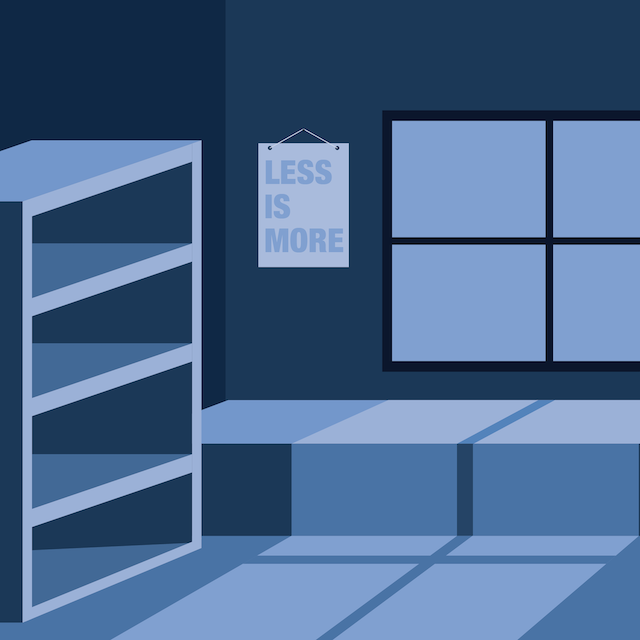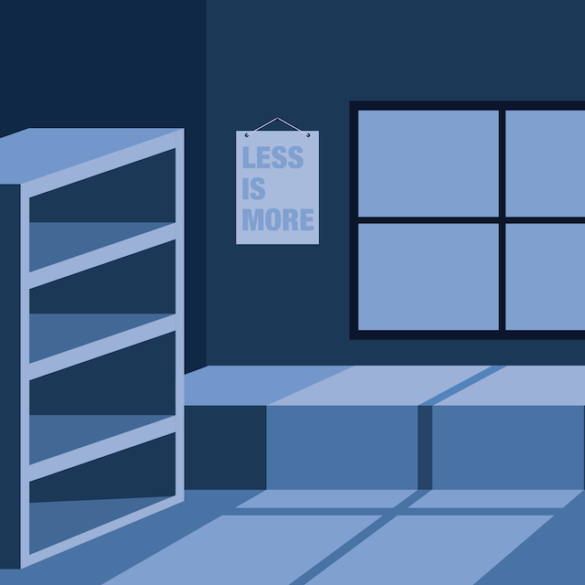Minimalism puts the phrase, “it’s the least I can do” to the test.
When thinking of material possessions, what do you consider to be most important? Do you keep only purposeful items? Could you get rid of those that were not? Minimalism, a movement which focuses on ridding “life’s excess in favor of focusing on what’s important,” invites its members to ask questions like these on a daily basis. But minimalism can’t be defined that easily. It isn’t as simple as owning less than 15 items or only using grayscale colors or downsizing a house. Minimalism comes in many forms.
According to Minimalist Co, a community site for followers of minimalism, the minimalist movement can be traced back as far as the 1800s. While the term itself was not coined this early, philosophers such as Ralph Waldo Emerson and Henry David Thoreau saw simplicity as a tool to help gain enlightenment.
Minimalism gained its first wave of popularity in the 60s and 70s, when artists and writers began focusing on more simplistic works. The same happened in design and simple living in the 80s. Sarah Angne Alfaro is an assistant professor of interior design at Ball State’s College of Architecture and Planning who has a passion for minimalism and minimalist design.
“Architecturally, minimalism is about keeping the structure and sort of the bare bones, but at the same time integrating design into the structure,” she says.
Angne Alfaro says one example of this design can be using materials as ornamentation, such as a specific veining of stone or graining of wood. She also notes the option of using nature, a concept she considers to be linked closely to minimalism, though sometimes overdone.
“When you think of minimalism and you think about nature, there’s this divide now that everybody’s going to biophilia, which is a term about inserting nature and the passion of life inside, and some people think being minimalist is just infusing a space with nature,” Angne Alfaro says.
She explains that this affection some people have for nature within the minimalism movement might stem from the cyclical aspect of it.
“Whether the leaf falls from the tree and grows into something to help nourish the soil, which makes more trees grow and more plants grow [or] the nuts fall off the tree and animals eat them, everything has a purpose in life. So, when you think about minimalism and the way you design and the way you live, everything that you have should have a purpose, and if it’s exceeding that purpose, maybe you don’t need it,” she explains.
While some people’s minimalist practices are strictly design-oriented, others use minimalism in many aspects of their lives, such as organizationally and financially. Jennifer Morrow’s reasons for becoming minimalist were simple: she wanted her clothes to be more organized, and she wanted to know where her scissors were. She describes minimalism in a very unique way.
“[Minimalism] is like an iceberg,” she says. “It’s a very simple idea that is extraordinarily complex.”
Though she began practicing minimalism for those two reasons, it quickly became a part of her financial life, as well. She now considers financial minimalism to be the most important form she practices. Coming from a family that struggled financially, Jennifer can remember money being everything for her parents. Her childhood home had two mortgages, the credit cards were maxed out, and it resulted in a lot of fighting. She says this created a negative relationship with money for her, admitting she repeated a lot of those same habits once out of college.
“People don’t like to know how much money is coming in and going out. You just want to put it on autopilot and say ‘what will be, will be’,” Jennifer explains. “Money causes a lot of stress and anxiety for me personally, so I think anybody else that has that feeling, you can definitely apply minimalism in that way.”
Throughout her minimalist journey, Jennifer has created a website, a Facebook page and a YouTube channel where she shares her story and offers advice for those following a similar path. She calls her pages, “Minimalist My Way.”

“I called my site Minimalist My Way because that’s how I do it, but it’s not the only way,” she says. “I’m not selling anything. I don’t do anything for money. It’s just me wanting to share with other people and help other people as people have helped me.”
On top of her own pages, she is also a part of various minimalist communities online, but she notes a lack of people practicing minimalism within her close circle outside of the virtual world.
“I definitely don’t have a lot of minimalist acquaintances face to face,” she says. “There’s just not very many of us yet, but it is growing with leaps and bounds.”

According to a survey by Civic Science, minimalism has grown in popularity over the last few years, though a majority of Americans do not consider themselves to be minimalists. In fact, 38 percent of both Millennials and Generation X say they are actively working to become minimalists, while 38 and 34 percent respectively say they already are. Angne Alfaro says she believes minimalism’s popularity is on the rise because of an increase in digital culture’s influence.
“In this age of technology, we are so overwhelmed and overloaded and our brains are just exploding,” she says, “so we want to clear off those screens, we want to clear those to-do lists off, we want to get the shelves removed and organized, so I think everybody’s in this stage of removing and minimalizing their lifestyle.”
For those looking to begin their minimalist journey, Jennifer has a few suggestions.
“I would say a good place for everybody to start is their clothing,” she says.
She recommends watching Marie Kondo on Netflix and seeing her methods which involve piling all your clothes on the floor. Jennifer warns of the dangers of keeping things like aspirational clothing, or in other words, clothing that no longer fits that you hope to be able to fit into again someday.
“To me, aspirational clothing just makes you feel bad because it’s just reminding you of a deficit in yourself,” she says.
Jennifer also recommends capsule wardrobes. These consist of clothes that can be mixed and matched with everything, rather than buying lots of individual outfits that can only be worn in that combination alone.
With the holiday season in full effect, Jennifer recommends gifting consumables and experience-related gifts, such as purchasing an appointment at a hair salon for your minimalist friends. She also reminds those practicing minimalism to be grateful even if the gift does not meet that criteria.
“The holidays are so emotionally-charged for so many people,” she says. “Receiving a gift is not a time for a lecture about why [the] effort and money bringing you this gift is now offensive to you. You can’t control other people, you can only control yourself and your reaction to other people, so I would just say [to] communicate early.”
She recommends everyone do their research and avoid the common misconceptions about minimalism — misconceptions she attributes in part to sensationalizing of it by the media.
“You hear about the guy that quit his job, and he only owns 15 things, and he sleeps on people’s couches,” she details. “And okay, I guess that’s minimalism for that guy. That’s great, but that’s not mainstream.”
Whether it’s interior design of your home, the managing of your finances, or only owning 15 items, minimalism is a growing part of many people’s lives where the options, though ironic, are limitless.
Sources: The Minimalists, Minimalist Co., Minimalist My Way, Minimalist My Way, Minimalist My Way, Netflix
Images: Provided by Jennifer Morrow
Featured Image: Alex Bracken




